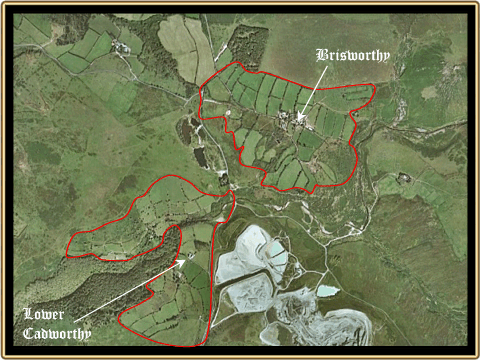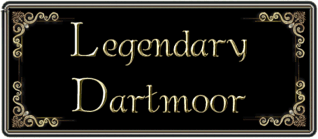
Look on any map of Dartmoor and you will find many place-names that end with the element – worthy, but what was a ‘worthy’ and how old are they? That latter question is probably the easiest to answer insomuch as it has been suggested that they originated in Anglo Saxon times. In Clark-Hall’s Anglos Saxon dictionary (2004, p.419) he lists the word – worõig as meaning an enclosed homestead, farm or curtilage, and this is the word from which ‘worthy’ has derived. Faith (2007, pp.9) tells us how worthys are one of a few references that actually occur in the Anglo Saxon lawcodes where under the umbrella of farming practicalities it is recorded that, “A ceorl’s (a free man) worthy must be fenced winter and summer. If it’s not fenced and his neighbours beast strays in through his own opening he shall have no claim to that beast: he shall drive it out and suffer the damage“,
So from this it can be surmised that we are looking at an early farm of one kind or another that was enclosed or ‘ring fenced’. There are also examples of worthys which could be classified as hamlets such as Hexworthy and Ponsworthy to name but two. Faith (p.9) slightly disagrees with and considers that ‘worth’ derives from the word wurth which means soil, again this can be associated with a farm. In many of the Dartmoor worthys the first element of the place-name is a personal one that denotes a name, for example; Yardworthy was Eada’s worõig, below is a list of some of the more obvious worthy place-names that occur on Dartmoor along with their original names, (Glover et al, 1992, 1998 pp. various).
| Name | OS Grid. Ref. | Old Name | Name | OS Grid. Ref. | Old Name |
| BADWORTHY BROOK | SX 677 609 | Bada’s worõig | HIGHER GODSWORTHY | SX 5301 7727 | Gõde’s worõig |
| BATWORTHY | SX 7174 8525 | Bada’s worõig | HIGHER WILLSWORTHY | SX 5359 8167 | Wifel’s worõig |
| BATWORTHY | SX 6609 8660 | Bada’s worõig | HUCKWORTHY | SX 5324 7042 | Hana’s worõig |
| BRISWORTHY | SX 5600 6520 | Beorhtwine worõig | LANGWORTHY | SX 5244 8538 | Long worõig |
| CADWORTHY WOOD | SX 544 641 | Cada’s worõig | LOWER BADWORTHY | SX 6817 6192 | Bada’s worõig |
| COLESWORTHY | SX 8030 7565 | Chauelesweye – 1200 | LOWER CADWORTHY | SX 5493 6433 | Cada’s worõig |
| DIDWORTHY | SX 685 622 | Dudda’s worõig | LOWER GODSWORTHY | SX 5278 7761 | Gõde’s worõig |
| DITSWORTHY | SX 586 663 | Deorc’s worõig | LOWER NATSWORTHY | SX 7225 7965 | Hnott’s worõig |
| EGGWORTHY | SX 5440 7190 | Ecca’s worõig | NATSWORTHY MANOR | SX 7211 7998 | Hnott’s worõig |
| EMSWORTHY | SX 7458 7655 | Afan’s worõig ? | NORSWORTHY | SX 5683 6945 | North’s worõig |
| ENSWORTHY HILL | SX 648 899 | Afan’s worõig ? | PONSWORTHY | SX 7018 7406 | Pauntesford -1281 |
| ESSWORTHY | SX 55?? 68?? | Essa’s worõig | TEIGNWORTHY | SX 6764 8564 | Teign worõig |
| FERNWORTHY | SX 662? 839? | Bracken worõig | THORNWORTHY FARM | SX 6703 8490 | Thorn worõig |
| FOXWORTHY | SX 6942 7409 | Færoc’s worõig | TROWLESWORTHY | SX 5678 6478 | Travell’s worõig ? |
| FOXWORTHY | SX 7581 8210 | Færoc’s worõig | WAPSWORTHY | SX 5378 8019 | Wærbeorht’s worõig |
| GREAT ENSWORTHY | SX 6603 8949 | Afan’s worõig ? | WILLSWORTHY | SX 8013 7645 | Wifel’s worõig |
| HEXWORTHY | SX 654 728 | Hēahstãn’s worõig | YARDWORTHY | SX 6790 8512 | Eada’s worõig |
| HIGHER BADWORTHY | SX 6808 6171 | Bada’s worõig |
There are 35 place names in this list of which Colesworthy and Ponsworthy are red-herrings insomuch that the modern ‘worthy’ element did not originally exist. There are 4 worthy place name with a descriptive element; Fernworthy, Langworthy, Teignworthy and Thornworthy which leaves 29 place-names where the first element comprises of a personal name which would indicate that the worthy was a possession of the named person. It is in this very fact that the answer as to what a worthy was could possibly lie, similar such enclosed farms have been identified elsewhere in Britain. My university lecturer, Jon Kissock has identified such units on the Gower peninsula which he considers to belong to multiple estates. This phenomenon is basically where an estate or manor is made up of several farms, each performing a different function such as arable or pastoral activities for the good of the overall community. Roberts and Wrathmell have studied worthys and have suggested that there is a connection between the early place-name and woodlands that are recorded in the Domesday Book and conclude that the worthy place-names: “represent a category of individual farmsteads within or on the edge of woodland tracts“, (2002, p.180). It is interesting to see that the Dartmoor examples of worthys are mostly located on the moorland margins and apart from Colesworthy and Willsworthy do not occur above a line between Ashburton and Horrabridge. So, basically this idea is based upon the assumption that these worthys were farms that had been reclaimed from the moorland fringes and woodlands thus carrying the name of the person who did so.
However, there is one other idea, Faith, (2007, p.12) suggests that a worthy could be viewed as:
“a journey to the margin as a result of the increased pressure of population in the eleventh, twelfth and thirteenth centuries. Certainly some new farms were established, and failed, on Dartmoor as part of this movement. The Dartmoor worthys could possibly be seen like this, as part of the shifting margin of cultivation on the edge of the moor“.
The, “increased pressure of population“, meant that there were more mouths to feed that the current agricultural lands could support, this then meant using marginal, moorland areas in an effort to increase food outputs.
So to summarise a worthy, it is of an Anglo Saxon origin and comprises of a ring-fenced farming unit that were located near woodland edges or moorland edges. The majority of place-names consist of a primary personal element which could well be representative of the original landowner who would have been independent of any manor or estate. The fields would have tended to be long and curving or lobe shaped and in some cases are still distinguishable in the modern landscape. It may well be that these newly reclaimed farming units were as a result of the greatly increased demand for food to feed a rapidly growing population. Below is an aerial photograph of Brisworthy and Lower Cadworthy which clearly shows the typically long, curved boundary banks of the enclosures.

It would be mis-leading to claim that worthys are a unique Dartmoor occurrence but it is a fact that there are a higher proportion of worthys around the moor when compare3d to the parts of the country. Devonshire as a whole could possibly claim to be the county with the highest number of recorded worthys.
As the centuries past it is interesting to see that the word ‘worthy’ became applicable to a type of person and opposed to a place. A worthy was a person of note and fame who merited respect or esteem, could it be that this same definition was applied to the worthy farms and then later transferred to someone who owned such a place?

Clark Hall, J. R. 2004 A Concise Anglo-Saxon Dictionary, Cambridge University Press, Canada.
Faith, R. 2007 Worthys and Enclosures, Medieval Settlement Research Group – Annual Report 21, MSRG, Cambridge.
Gover, J. E. B., Mawer, A. & Stenton, F. M. 1992 The Place Names of Devon. English Place-Name Society, Nottingham.
Gover, J. E. B., Mawer, A. & Stenton, F. M. 1998 The Place Names of Devon. English Place-Name Society, Nottingham.
Roberts, B. K. & Wrathmell, S. 2002 Region and Place, English Heritage, London.
 Legendary Dartmoor The many aspects past and present of Dartmoor
Legendary Dartmoor The many aspects past and present of Dartmoor

One comment
Pingback: Huish, Worthy, Buckland, Combe – Devonshire Place Names | Dartmoor Hiking